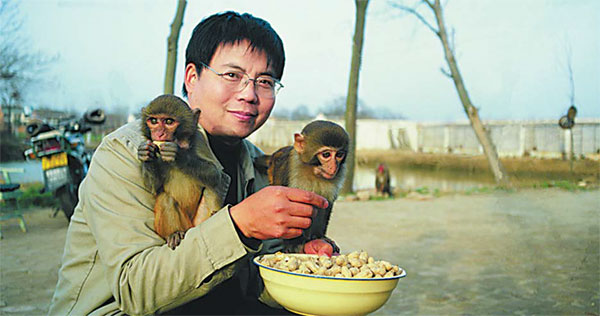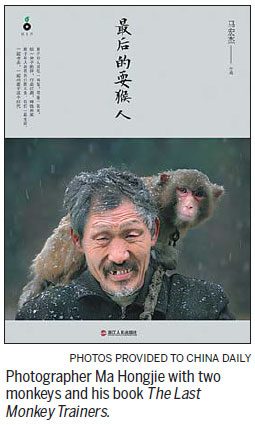Monkey trainers last of a dying species

Chinese photographer Ma Hongjie traveled across China for more than a decade documenting the lives of people who train monkeys for roadside shows, once a popular form of entertainment in China, but now on the decline.
People used to watch monkeys perform tricks and paid their trainers, not just in China but elsewhere.
Today, apart from a few surviving circuses, people are shunning animal shows everywhere. In China, urban management authorities mostly forbid monkey trainers from using public areas for the purpose, and sometimes even fine them heavily.

In 2001, Ma, 52, decided to follow a group of trainers from Xinye county, Nanyang city, in Central China's Henan province, to take their photos.
He had earlier seen some monkeys perform in the street, and he tracked the trainers down to their hometown, where people had been engaged in training the animals for generations.
When Ma took their pictures, he persuaded the trainers to tell him their stories. The project was originally intended to be a photo album. But after 12 years on the road with the group, he felt a strong desire to add a lot of text to explain his photos, and so the book, The Last Monkey Trainers, was published this year.

The book tells of the joy and sorrow of those engaged in a fast disappearing trade.
"For people living in big cities, it is difficult to imagine the life of the unprivileged. But when you are there you realize they are similar to you," Ma said at a Beijing event recently for his book.
A 57-year-old trainer by the name of Yang Lin'gui is the main character in Ma's book.
Yang entered the profession when he was 29, and has often smuggled his monkeys on trains because of the rules governing the carriage of live animals on public transport. But he also did it to save money.
Yang, like his fellow trainers, formed small groups to make money mostly through street performances.
Inns were a luxury they could not afford, so they lived in abandoned factories or uninhabited shelters, sometimes even sleeping under the open sky.
They had very little food to eat, usually just plain noodles and steamed buns for days.
While the popularity of monkey trainers has fallen even in rural China, they also face sharp criticism from animal protection organizations.
Even though there are no reliable statistics on monkey trainers, it is widely believed that there are about 1,000, and the young generation is not taking to the ancient profession as it is seen to be at odds with public empathy for animals in the modern world, the book says.
"It is getting more and more difficult to make a living out of training and performing with monkeys," Yang says.
Yang followed in his father's footsteps to become a monkey trainer, but his son, unwilling to accept the family legacy, has opted out to work in a factory in Guangdong province, the book says.
Yang Jinlin, a culture critic and former Phoenix TV commentator, praised Ma for presenting a complex subject in an objective way.
liuzhihua@chinadaily.com.cn
(China Daily European Weekly 03/27/2015 page28)
Today's Top News
- Japan tempting fate if it interferes in the situation of Taiwan Strait
- Stable trade ties benefit China, US
- Experts advocate increasing scope of BRI to include soft power sectors
- New engine powers cargo drone expansion
- China to boost green industry cooperation
- Manufacturing PMI rises in November






























